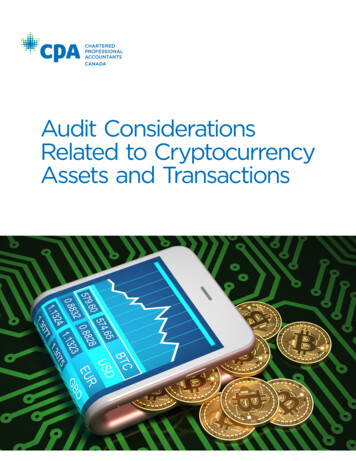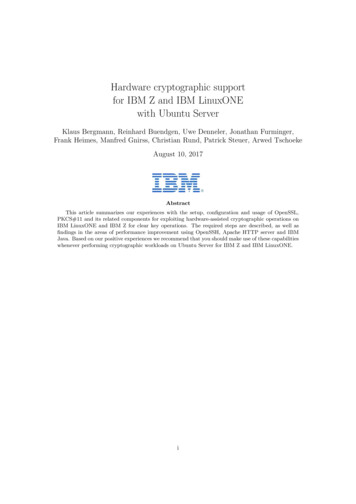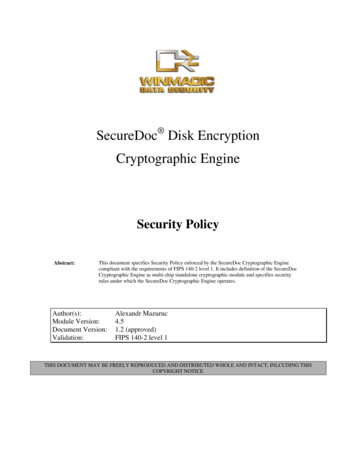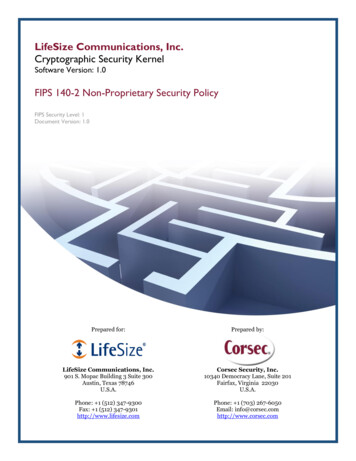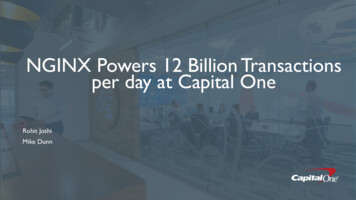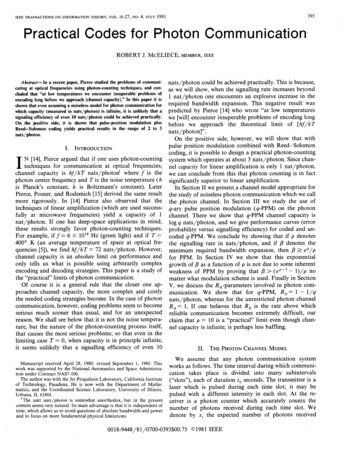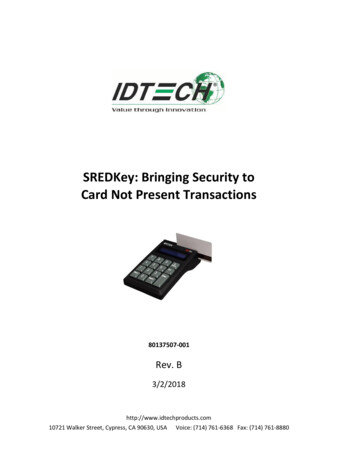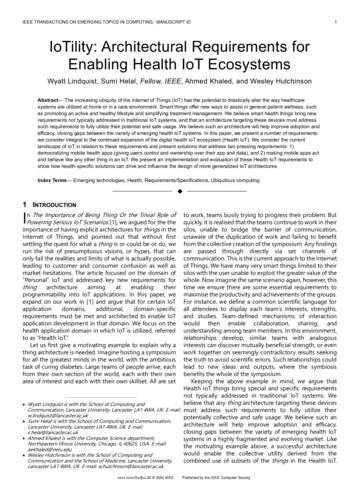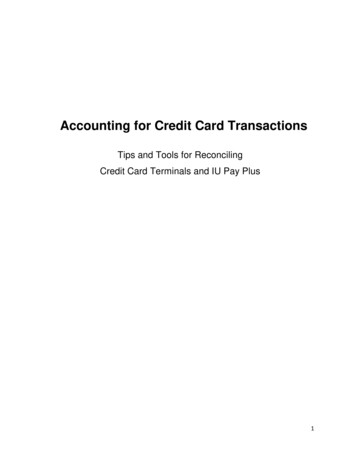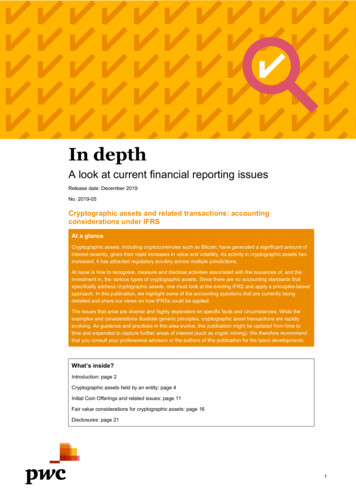
Transcription
In depthA look at current financial reporting issuesRelease date: December 2019No. 2019-05Cryptographic assets and related transactions: accountingconsiderations under IFRSAt a glanceCryptographic assets, including cryptocurrencies such as Bitcoin, have generated a significant amount ofinterest recently, given their rapid increases in value and volatility. As activity in cryptographic assets hasincreased, it has attracted regulatory scrutiny across multiple jurisdictions.At issue is how to recognise, measure and disclose activities associated with the issuances of, and theinvestment in, the various types of cryptographic assets. Since there are no accounting standards thatspecifically address cryptographic assets, one must look at the existing IFRS and apply a principles-basedapproach. In this publication, we highlight some of the accounting questions that are currently beingdebated and share our views on how IFRSs could be applied.The issues that arise are diverse and highly dependent on specific facts and circumstances. While theexamples and considerations illustrate generic principles, cryptographic asset transactions are rapidlyevolving. As guidance and practices in this area evolve, this publication might be updated from time totime and expanded to capture further areas of interest (such as crypto mining). We therefore recommendthat you consult your professional advisers or the authors of this publication for the latest developments.What’s inside?Introduction: page 2Cryptographic assets held by an entity: page 4Initial Coin Offerings and related issues: page 11Fair value considerations for cryptographic assets: page 16Disclosures: page 211
1. Introduction1.1. BackgroundCryptographic assets are transferable digital representations that are designed in a way that prohibits theircopying or duplication. The technology that facilitates the transfer of cryptographic assets is referred to as a‘blockchain’ or distributed ledger technology. Blockchain is a digital, decentralised ledger that keeps a recordof all transactions that take place across a peer-to-peer network and that enables the encryption ofinformation. Cryptographic assets and the underlying technology provide opportunities to digitise a variety of‘real world’ objects. The benefits of digitisation (such as ease of access, transfer, etc) have resulted incryptographic assets growing from an obscure curiosity to a technology that is proliferating into a variety ofbusiness uses.There is no legal definition of cryptographic assets, as there is for securities in various jurisdictions; however,some cryptographic assets can legally be considered securities by local regulators. It is important to note thatthere are various subsets of cryptographic assets. Cryptographic assets are used for a variety of purposes,including as a means of exchange, as a medium to provide access to blockchain-based goods or services,and as a way to raise funding for an entity developing activities in this area.One of the most commonly known subsets of cryptographic assets are cryptocurrencies, which are mainlyused as a means of exchange and share some characteristics with traditional currencies. The markets areevolving fast, but currently two of the most prominent cryptocurrencies are Bitcoin and Ether.These transformative technologies have not gone unnoticed by the standard setters. The topic of digitalcurrencies was identified as a potential new project for the IASB in 2015 through the Board’s AgendaConsultation process. However, the Board decided not to act immediately but to continue to monitordevelopments.As part of that process, the Accounting Standards Advisory Forum (‘ASAF’), an IFRS Foundation advisoryforum consisting of representatives from national and supra-national accounting standard setters, discusseddigital currencies at a meeting in December 2016. The debate was focused on the classification of acryptographic asset from the holder’s perspective. Conversations have continued in various accountingstandards boards, but no formal guidance has been issued by the IASB at this point.At the July 2018 Board meeting, the IASB reached an agreement to ask the IFRS Interpretations Committee(‘IFRS IC’) to consider guidance for the accounting of transactions involving cryptocurrencies, possibly in theform of an agenda decision on how an entity might walk through the existing IFRS requirements.In June 2019, the IFRS IC published its agenda decision on ‘Holdings of Cryptocurrencies’, and it considereda subset of cryptographic assets with the following characteristics:a.b.c.a digital or virtual currency recorded on a distributed ledger that uses cryptography for security;not issued by a jurisdictional authority or other party; anddoes not give rise to a contract between the holder and another party.The IFRS IC concluded that IAS 2, ‘Inventories’, applies to such assets where they are held for sale in theordinary course of business. If IAS 2 is not applicable, an entity applies IAS 38, ‘Intangible Assets’, toholdings of cryptocurrencies.There are many judgemental areas that will require further investigation as entities determine the applicableaccounting treatment and as the technologies and markets continue to develop. For some topics, no uniformor definitive answers currently exist.1.2. Frequently used termsSome terms used in relation to cryptographic assets will also be used in this publication. This sectionexplains these terms.Coin/TokenA cryptographic asset might be described as either a ‘token’ or a ‘coin’. The difference is based on theasset’s functionality but, in practice, the terms can be used interchangeably, because no universallyaccepted definition of either exists. Currently, the term ‘coin’ generally refers to a cryptographic asset thathas the express purpose of acting solely as a medium of exchange, while the term ‘token’ refers to an assetthat gives the holder additional functionality or utility. The rights conveyed by a token are typically set out in awhitepaper or similar document by the issuing organisation.In depth2
WhitepaperA whitepaper is a concept paper authored by the developers of a platform, to set out an idea and overallvalue proposition to prospective investors. The whitepaper commonly outlines the development roadmap andkey milestones that the development team expects to meet.PlatformThe term ‘platform’ refers to software that provides a utility or services to users of the software. To facilitatethe use of the software, users must own or use a particular coin or token.Initial Coin OfferingInitial Coin Offerings or ‘ICOs’ have become a prevalent means for developers to sell blockchain tokens orcoins to investors. When an ICO is undertaken, the issuer receives consideration in the form of cash oranother cryptographic asset (most commonly, a cryptocurrency such as Bitcoin or Ether). In exchange, thedeveloper might issue (or promise to issue) a digital token to the parties that provided contributions for thedevelopment of the digital token.It should be noted that ICOs might be subject to local securities law, and significant regulatory considerationsmight apply.Fiat currencyA fiat currency denotes paper money or coins of little or no intrinsic value in themselves and not convertibleinto gold or silver, but made legal tender by fiat (order) of the government (such as US Dollar or Euro).1.3. Relevant characteristics for accounting purposesFor the purposes of determining which accounting standard applies and discussing the related accountingissues, it is useful to classify cryptographic assets into defined subsets based on their characteristics.A single, generally accepted framework for the classification of these varied cryptographic assets does notcurrently exist. There is consequently no generally applied definition of a cryptographic asset. This reflectsthe broad variety of features and bespoke nature of the transactions in practice. However, based on ourobservations, there are some characteristics that can be used to classify cryptographic assets into similartypes. We believe that similar types of cryptographic asset should be accounted for in a similar way.The characteristics that we observe being most relevant for classifying cryptographic assets for accountingpurposes are: the primary purpose of the cryptographic asset; andhow the cryptographic asset derives its inherent value.Although a range of other characteristics exist, we view these as not being fundamental to determining acommon accounting treatment.In depth3
Based on the characteristics detailed above, we have defined four specific subsets of cryptographic assets,as set out in the following table:SubsetPurposeInherent ValueCryptocurrencyCryptocurrencies are digital tokens or coins based onblockchain technology, such as Bitcoin. They currentlyoperate independently of a central bank and are intended tofunction as a medium of exchange.None – derives itsvalue based on supplyand demand.Asset-backedtokenAn asset-backed token is a digital token based on blockchaintechnology that signifies and derives its value fromsomething that does not exist on the blockchain but insteadis a representation of ownership of a physical asset (forexample, natural resources such as gold or oil).Derives its value basedon the underlyingasset.Utility tokenUtility tokens are digital tokens based on blockchaintechnology that provide users with access to a product orservice, and they derive their value from that right. Utilitytokens give holders no ownership in a company’s platform orassets and, although they might be traded between holders,they are not primarily used as a medium of exchange.Value is derived fromthe demand for theissuer’s service orproduct.Security tokenSecurity tokens are digital tokens based on blockchaintechnology that are similar in nature to traditional securities.They can provide an economic stake in a legal entity:sometimes a right to receive cash or another financial asset,which might be discretionary or mandatory; sometimes theability to vote in company decisions and/or a residual interestin the entity.Value is derived fromthe success of theentity, since the holderof the token shares infuture profits orreceives cash oranother financial asset.It should also be noted that some cryptographic assets might exhibit elements of two or more of the identifiedsubclasses. These result in hybrid cryptographic assets that will have to be assessed further. This documentfocuses on cryptographic assets that carry simple features, instead of hybrid tokens.PwC observations:Before determining the accounting treatment of a transaction from the issuer’s or owner’s perspective, it isimportant to understand the purpose and utility of the cryptographic asset. There is diversity of rights andobligations associated with cryptographic assets. Reading the whitepaper can provide insights into theterms/characteristics of the cryptographic asset that might result in differences in the accounting modelapplied.2. Cryptographic assets held by an entity2.1. General observationsIFRS does not include specific guidance on the accounting for cryptographic assets and there is no clearindustry practice, so the accounting for cryptographic assets could fall into a variety of different standards.Consideration should also be given to the entity's purpose for holding the cryptographic assets to determinethe accounting model. We explore below the accounting standards and other considerations that might berelevant to the subsets of cryptographic assets.In depth4
2.2. Cryptocurrencies held for own account2.2.1. Applicable standardA few standards come to mind when considering the accounting for cryptocurrencies held by an entity for itsown account.Cash or a currencyIFRS contains no explicit definition of the terms ‘cash’ or ‘currency’. There might be an argument that, foraccounting purposes, the words ‘cash’ and ‘currency’ are interchangeable. IAS 32, ‘Financial Instruments:Presentation’, makes a connection between currency and cash, and IAS 21, ‘The Effects of Changes inForeign Exchange Rates’, makes a connection between cash, currency and monetary items.Judgement is therefore required to determine whether cryptocurrencies can be considered cash or acurrency.Cryptocurrencies do not have some of the common properties of cash and currency, especially: cryptocurrencies are not legal tender and mostly are not issued or backed by any government or state;andcryptocurrencies are currently not capable of setting prices for goods and services directly. In otherwords, cryptocurrencies might be accepted to settle some transactions, but they are not directlyrelated to the setting of prices for goods or services in an economy.The assessment should consider the facts and circumstances for each cryptocurrency. At the time of writing(November 2019), we have not seen a cryptocurrency that could be considered cash or a currency underIFRS. We note that Venezuela has launched a government-backed cryptocurrency; companies holding unitsof this cryptocurrency might need to consider whether it meets the definition of cash or a currency by takinginto account the factors described above, as well as any relevant legal and regulatory questions regarding itsvalidity.Financial asset – other than cashHolding a unit of a cryptocurrency typically does not give the holder a contractual right to receive cash oranother financial asset, nor does the cryptocurrency come into existence as a result of a contractualrelationship. Moreover, cryptocurrencies do not provide the holder with a residual interest in the assets of anentity after deducting all of its liabilities. Therefore, cryptocurrencies that we have seen so far (November2019) do not meet the definition of a financial asset.Property, plant and equipmentCryptocurrencies do not fall into the scope of IAS 16, ‘Property, Plant and Equipment’, because they are nottangible items.InventoryIAS 2 does not require inventories to be in a physical form, but inventory should consist of assets that areheld for sale in the ordinary course of business. Inventory accounting might be appropriate if an entity holdscryptocurrencies for sale in the ordinary course of business. An entity that actively trades thecryptocurrencies, purchasing them with a view to their resale in the near future and generating a profit fromfluctuations in the price or traders’ margin, might consider whether the guidance in IAS 2 for commoditybroker-traders should be applied.However, if the entity holds cryptocurrencies for investment purposes (that is capital appreciation) overextended periods of time, it would likely not meet the definition of inventory.PwC observations:If it is determined, based on the entity’s business model, that inventory accounting is appropriate,inventories would typically be measured at the lower of cost and net realisable value. An entity that holdscryptocurrencies to sell them in the near future, generating a profit from fluctuations in prices or traders’margin, might apply the commodity broker-trader exception in IAS 2. The term ‘commodity’ is not definedin IAS 2, but a broker-trader that concluded a cryptocurrency was a commodity would measure theinventory at fair value less cost to sell, with changes in fair value recognised in profit or loss.In depth5
Intangible assetIf a cryptocurrency does not meet the definition of any of the above categories, it will likely meet the definitionof an intangible asset under IAS 38, ‘Intangible Assets’, because: it is a resource controlled by an entity (that is, the entity has the power to obtain the economic benefitsthat the asset will generate and to restrict the access of others to those benefits) as a result of pastevents and from which future economic benefits are expected to flow to the entity;it is identifiable, because it can be sold, exchanged or transferred individually;it is not cash or a non-monetary asset; andit has no physical form.IAS 38 applies to all intangible assets except those excluded specifically from its scope (for example,inventories).2.2.2. Measurement considerationsThe analysis above suggests that there are a number of different asset standards that might apply forcryptocurrencies.The chart below summarises the different possible classifications and their associated lmeasurementSubsequentmeasurementMovements incarrying amountInventory (IAS 2)CostLower of cost and netrealisable valueMovements above cost- Other- N/AMovements below cost- Profit and lossInventory (IAS 2)CostFair value less costs tosellProfit and lossCostFair value less anyaccumulatedamortisation andimpairment*Movements above cost- Commodity brokertrader exceptionIntangible assets (IAS38)- Revaluation model(accounting policychoice but requiresexistence of activemarket)Intangible assets (IAS38)- Cost model- Other comprehensiveincomeMovements below cost- Profit and lossCostCost less anyaccumulatedamortisation andimpairment*Movements above cost- N/AMovements below cost- Profit and loss* in most cases, no amortisation is expected for cryptocurrenciesIn depth6
PwC observations:The range of possible classifications, as well as their associated measurement, indicates the importanceof understanding the nature and characteristics of the cryptocurrency, as well as the entity’s businessmodel/purpose for holding the asset. This increases the importance of implementing specific accountingpolicies and ensuring their consistent application to similar transactions, as well as appropriatedisclosures. Where an entity can evidence the existence of clearly distinguished portfolios of similarassets held for different purposes, different treatments might apply within an entity.2.3. Cryptographic assets other than cryptocurrencies held for own account2.3.1. Applicable standardA similar thought process will apply when considering the accounting for cryptographic assets other thancryptocurrencies. Those cryptographic assets include security tokens, asset-backed tokens and utility tokens(together referred to as ‘crypto tokens’) held by an entity for own account.Cash or a currencyCrypto tokens are issued not as a general-purpose medium of exchange, but to provide holders with otherrights, including rights to goods or services or certain underlying physical assets.Judgement is required to determine whether crypto tokens can be considered cash or a currency. However,since crypto tokens generally lack the properties of cash (described in section 2.2.1 above), they are unlikelyto be considered cash or a currency under IFRS.Financial asset – other than cashCertain crypto tokens give the holder a right to cash or a financial asset. This could be based on futureperformance of a platform, a residual interest in net assets, or the value of an underlying asset. However,further consideration is needed to verify whether such rights and obligations are legally enforceable, sincefinancial assets can only arise from a legally enforceable contractual relationship.Unless crypto tokens provide the holder with a right to cash or another financial asset, they will not meet thedefinition of a financial asset.For the classification and measurement of crypto tokens that meet the definition of a financial asset, entitiesshould follow the guidance in IFRS 9, ‘Financial Instruments’.Property, plant and equipmentCryptographic assets do not fall into the scope of IAS 16, because they are not tangible items.InventoryIAS 2 does not require inventories to be in a physical form, but inventory should consist of assets that areheld for sale in the ordinary course of business. Inventory accounting might be appropriate if an entity holdscryptographic assets for sale in the ordinary course of business. An entity that actively trades thecryptographic assets, purchasing them with a view to their resale in the near future and generating a profitfrom fluctuations in the price or traders’ margin, might consider whether the guidance in IAS 2 for commoditybroker-traders should be applied.However, if the entity holds crypto tokens for investment purposes (that is, capital appreciation) overextended periods of time, it would likely not meet the definition of inventory.Measurement guidance for crypto tokens that meet the definition of inventory can be found in section 2.2above.In depth7
Intangible assetDepending on the rights associated with a crypto token, it could potentially also meet the definition of anintangible asset under IAS 38 if: it is a resource controlled by an entity (that is, the entity has the power to obtain the economic benefitsthat the asset will generate and to restrict the access of others to those benefits) as a result of pastevents and from which future economic benefits are expected to flow to the entity;it is identifiable, because it can be sold, exchanged or transferred individually;it is not cash or a non-monetary asset; andit has no physical form.IAS 38 applies to all intangible assets except those excluded specifically from its scope (for example,inventories).Measurement guidance for crypto tokens that meet the definition of an intangible asset can be found insection 2.2 above.PrepaymentCrypto tokens might provide the holder with a right to future goods or services. These tokens are aprepayment for future goods or services. A prepayment for future goods or services might meet the definitionof an intangible asset.Where the prepayment does not meet the definition of an intangible asset, the accounting will be similar tothe accounting for other prepaid assets.Measurement guidance for crypto tokens that meet the definition of an intangible asset can be found insection 2.2 above.Underlying assetIn some situations, crypto tokens provide the holder with an interest in an underlying asset. The underlyingassets might be commodities (such as gold or oil), intangible assets (such as a licence or a patent), artworkor real estate. While some asset-backed tokens represent a real claim on the asset itself, others have noability to redeem the actual underlying.Where the crypto token represents a contractual right to receive cash equivalent to the value of theunderlying asset, it might meet the definition of a financial asset. If the crypto token represents a right to theasset itself, it might be accounted for in a manner similar to the underlying asset.Crypto tokens that are accounted for in a manner similar to the underlying asset will be measured followingthe relevant accounting standard for the underlying asset.2.3.2. Application to categories of crypto tokensWhen applying the thought process set out above to the categories of crypto tokens described in section 1.3above, general observations can be summarised as follows:(1) Crypto tokens with the characteristics of asset-backed tokensAsset-backed tokens might give the holder a right to an underlying asset. These tokens could be used totransfer the ownership of underlying assets without physically moving them. It is a means to transact theunderlying asset at minimal cost. As a result, the accounting will likely be driven by the nature of theunderlying asset and the relevant accounting standard.(2) Crypto tokens with the characteristics of utility tokensUtility tokens usually give the holder a right to future goods or services. These tokens are a prepayment forgoods or services. A prepayment for goods or services might meet the definition of an intangible asset andIAS 38 could be applied. Where it does not meet the definition of an intangible asset, it is accounted forsimilar to other prepaid assets.In depth8
(3) Crypto tokens with the characteristics of security tokensSecurity tokens might give the holder a right to cash, based on the platform’s future profits or a residualinterest in the net assets. Such rights might be discretionary or mandatory, and they might be accompaniedby the ability to vote to impact decisions relating to the underlying platform. A contractual right to cash oranother financial asset might exist in these circumstances, in which case these security tokens meet thedefinition of a financial asset subject to IFRS 9.(4) Crypto tokens with hybrid characteristicsCrypto tokens exhibiting elements of two or more subclasses require further analysis, and judgement isrequired to determine the applicable accounting treatment. Factors to consider will include the interaction ofcontractual clauses, and their substance and relevance in the context of the overall characteristics of thetoken.2.4. Cryptographic assets held on behalf of third parties2.4.1. Practical observations and resulting challengesCryptographic assets might also be held by an entity on behalf of its customers. Some examples are: An entity that operates a trading platform that enables its customers to exchange differentcryptographic assets, or to exchange fiat currency for a cryptographic asset.An entity (such as a bank or similar financial services entity) that offers custodian services for itscustomers’ cryptographic assets. In this case, customers lodge cryptographic assets with the entity forsafe keeping.Arrangements for holding such cryptographic assets vary. In most cases, there will be some indication (suchas a contract, or a statement in a whitepaper) that the cryptographic asset is held on behalf of customers,and that sets out what customers need to do to access or use the cryptographic asset. The other features ofthe arrangement might vary, including (but not limited to) the following: The ability of the entity to ‘borrow’ the cryptographic assets to use for its own purposes. Even if such aright is not explicitly contained in the arrangement with the customers, it might be implicit, dependingon the degree of segregation of the customers’ assets (see below).The degree of segregation of cryptographic assets held on behalf of customers from cryptographicassets ‘owned’ by the entity.The claims of customers in the event that the entity is liquidated. They might vary or be unclear.Customers might have the status of unsecured creditors, with no preferential claim on thecryptographic assets held by the entity on their behalf.The security of the assets. Cryptographic assets held on behalf of customers might be held in either a‘hot wallet’ (connected to the internet), a ‘cold wallet’ (not connected to the internet, and harder toaccess) or a ‘warm wallet’ (offline, but easier to connect to than a cold wallet, often through the use ofhardware). The customer or the entity might hold, and might be able to use, the private key to thewallet.The degree to which the exchange/the entity/the customer is able to identify specific misappropriatedcryptographic assets through the blockchain technology.Whether cryptographic assets held on behalf of others are held in an account/wallet of the entity or inan account/wallet at a third party.The relevant law or regulations for cryptographic assets held on behalf of others; or, in some cases,whether there are specific laws and regulations governing such cryptographic assets.The extent to which the rights and obligations of the parties are clear or contractually enforceable (forexample, if contained in a whitepaper). In many cases, external legal opinions might help to establishthese. However, laws and regulations governing cryptographic assets are still developing, and so legalopinions might not prove conclusive.The key accounting question is whether or not such holdings of cryptographic assets on behalf of customersshould be recorded on or off the entity’s balance sheet under IFRS.2.4.2. Factors to consider when determining the accounting treatmentThere is no IFRS that directly provides guidance on whether an entity’s holding of cryptographic assets onbehalf of others should be presented on its balance sheet. We believe that such entities should consider thegeneral guidance in IAS 8, ‘Accounting Policies, Changes in Accounting Estimates and Errors’, in developingan accounting policy for such assets.In depth9
This requires consideration of existing IFRS dealing with similar and related issues and the definitions in theConceptual Framework (the ‘Framework’).The Framework defines ‘asset’ and ‘liability’ as follows:‘An asset is a present economic resourcecontrolled by the entity as a result of past events.An economic resource is a right that has thepotential to produce economic benefits.’‘A liability is a present obligation of the entity totransfer an economic resource as a result of pastevents.’In determining whether an asset and liability should be recognised on the balance sheet of the entity holdingthe cryptographic asset on behalf of customers, an entity considers: Whether it has the right (explicit or implicit) to ‘borrow’ the cryptographic assets to use for its ownpurposes. If the entity has such a right, it would seem that the definition of an asset set out above ismet.The rights of customers to cryptographic assets held on their behalf if the entity is liquidated. Inparticular, if customers would have the status of unsecured creditors with no preferential claim on thecryptographic assets held by the entity on their behalf, this is a strong indicator that the cryptographicassets and the corresponding liability should be recognised on the balance sheet, because theFramework definition of a liability would seem to be met.In practice, the level of segregation of the customers’ assets from the entity’s assets is critical in determiningwhich assets should be recognised on balance sheet (own assets and customer’s assets that are notsegregated) and which assets should be off balance sheet (assets that are segregated and that the entityholds as a custodian). Factors to consider include: Whether the rights and obligations of the entity and its customers are set out in a contract orwhitepaper (if any); whether the rights and obligations are contractually enforceable; and whetherexternal legal opinions are available as ev
Cryptocurrency . Cryptocurrencies are digital tokens or coins based on blockchain technology, such as Bitcoin. They currently operate independently of a central bank and are intended to function as a medium of excha
